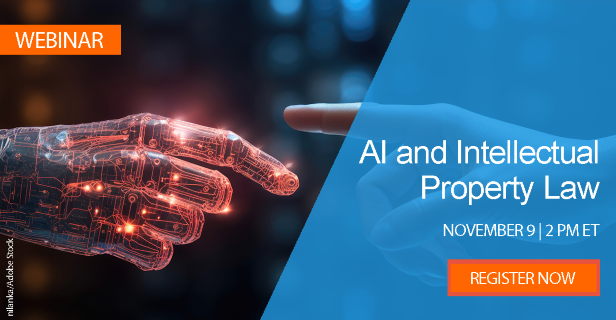Features

WEBINAR: AI & Intellectual Property
Owners of intellectual property should be aware of how their works are used by generative AI models and the users of these tools, and timely action should be taken to defend intellectual property against infringement. Join LJN for a free webinar on Nov. 9.
Features

WEBINAR: AI & Intellectual Property
Owners of intellectual property should be aware of how their works are used by generative AI models and the users of these tools, and timely action should be taken to defend intellectual property against infringement. Join LJN for a free webinar on Nov. 9.
Features

WEBINAR: AI & Intellectual Property
Owners of intellectual property should be aware of how their works are used by generative AI models and the users of these tools, and timely action should be taken to defend intellectual property against infringement. Join LJN for a free webinar on Nov. 9.
Features

Federal District Court Denies Copyright to Visual Art Piece Generated Solely By Artificial Intelligence
In August, the U.S. District Court of the District of Columbia affirmed the U.S. Copyright Office's denial of a copyright application for a visual piece of art generated entirely by an artificial intelligence-driven computer called the "Creativity Machine." Recognizing that U.S. "copyright law protects only works of human creation," the court determined that the Copyright Office "acted properly in denying copyright registration for a work created absent any human involvement."
Features

Protecting Artificial Intelligence Inventions: Takeaways from 'IBM v. Zillow' from a Patent Drafting Perspective
Part One of a Two-Part Article This two-part article sheds light on several important aspects of patents on AI technology. In Part One, we provide a general overview of the IBM v. Zillow lawsuit and discusses strategies to diversify patent portfolios to maximize protection on AI-related technology.
Features

The Rise of AI-Generated Voice Deepfakes
Several tech companies are making strides training speech recognition tools to mimic the speaker's voice. And while this can improve user clarity and accessibility for those with physical limitations, there is another, more troubling trend: the prevalence of "voice deepfakes" — creating synthetic voices from unknowing (or unwilling) participants using generative artificial intelligence.
Features

AI and Law Practice: Challenges and Opportunities
As technology continues to advance at an unprecedented pace, legal practitioners are presented with both challenges and opportunities to harness the power of AI in their practices. This article lays out a general roadmap for success in modern legal firms through the strategic incorporation of AI technologies.
Features

How D.C. Fed. Court Denied Copyright to AI-Created Artwork
The U.S. District Court for the District of Columbia recently upheld a final refusal by the U.S. Copyright Office to register a visual work that was "autonomously created by a computer algorithm running on a machine," which the plaintiff called the Creativity Machine and identified as the "author" of the work.
Features

Federal District Court Denies Copyright to AI-Generated Art Piece
Recognizing that U.S. "copyright law protects only works of human creation," the court determined that the Copyright Office "acted properly in denying copyright registration for a work created absent any human involvement."
Features

Online Extra: AI Copyright — Ethical and Legal Considerations for Marketing and Sales
Standing still and waiting to take action wasn't easy, but the patience paid off. Now, I understand some of AI's limitations and ways to leverage it to propel marketing and sales activities.
Need Help?
- Prefer an IP authenticated environment? Request a transition or call 800-756-8993.
- Need other assistance? email Customer Service or call 1-877-256-2472.
MOST POPULAR STORIES
- The 'Sophisticated Insured' DefenseA majority of courts consider the <i>contra proferentem</i> doctrine to be a pillar of insurance law. The doctrine requires ambiguous terms in an insurance policy to be construed against the insurer and in favor of coverage for the insured. A prominent rationale behind the doctrine is that insurance policies are usually standard-form contracts drafted entirely by insurers.Read More ›
- A Lawyer's System for Active ReadingActive reading comprises many daily tasks lawyers engage in, including highlighting, annotating, note taking, comparing and searching texts. It demands more than flipping or turning pages.Read More ›
- The Brave New World of Cybersecurity Due Diligence in Mergers and Acquisitions: Pitfalls and OpportunitiesLike poorly-behaved school children, new technologies and intellectual property (IP) are increasingly disrupting the M&A establishment. Cybersecurity has become the latest disruptive newcomer to the M&A party.Read More ›
- Abandoned and Unused Cables: A Hidden Liability Under the 2002 National Electric CodeIn an effort to minimize the release of toxic gasses from cables in the event of fire, the 2002 version of the National Electric Code ("NEC"), promulgated by the National Fire Protection Association, sets forth new guidelines requiring that abandoned cables must be removed from buildings unless they are located in metal raceways or tagged "For Future Use." While the NEC is not, in itself, binding law, most jurisdictions in the United States adopt the NEC by reference in their state or local building and fire codes. Thus, noncompliance with the recent NEC guidelines will likely mean that a building is in violation of a building or fire code. If so, the building owner may also be in breach of agreements with tenants and lenders and may be jeopardizing its fire insurance coverage. Even in jurisdictions where the 2002 NEC has not been adopted, it may be argued that the guidelines represent the standard of reasonable care and could result in tort liability for the landlord if toxic gasses from abandoned cables are emitted in a fire. With these potential liabilities in mind, this article discusses: 1) how to address the abandoned wires and cables currently located within the risers, ceilings and other areas of properties, and 2) additional considerations in the placement and removal of telecommunications cables going forward.Read More ›
- Guidance on Distributions As 'Disbursements' and U.S. Trustee FeesIn a recent case from the Bankruptcy Court for the District of Delaware, In re Paragon Offshore PLC, the bankruptcy court provided guidance on whether a post-plan effective date litigation trust's distributions constituted disbursements subject to the U.S. Trustee fee "tax."Read More ›
